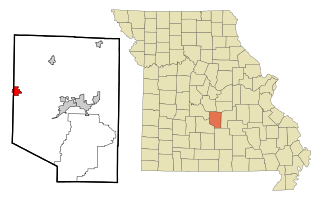
Pulaski County is a county located in the U.S. state of Missouri. As of the 2020 census, the population was 53,955. Its county seat is Waynesville. The county was organized in 1833 and named for Kazimierz Pułaski, a Polish patriot who died fighting in the American Revolution.

Laclede County is a county located in the U.S. state of Missouri. As of the 2020 census, the population was 36,039. Its county seat is Lebanon. The county was organized February 24, 1849, and was named after Pierre Laclède, founder of St. Louis.

Crocker is a city in Pulaski County, Missouri, United States. The population was 1,110 at the 2010 census.

St. Robert or Saint Robert is a city in Pulaski County, Missouri, United States. The population was 5,192 at the 2020 census. It is a gateway community to the United States Army installation at Fort Leonard Wood.

Waynesville is a city in and the county seat of Pulaski County, Missouri, United States. Its population was 5,406 at the 2020 census. Located in the Missouri Ozarks, it was once served by Route 66.

Richland is a city in Camden, Laclede, and Pulaski counties in the U.S. state of Missouri. The population was 1,863 at the 2010 census.

Devils Elbow is an unincorporated community in Pulaski County, Missouri, United States on historic U.S. Highway 66. It is situated on the Big Piney River and is named for a tight incised meander in the river known as a "devil of an elbow". The community is approximately five miles (8 km) east of St. Robert.

Buckhorn is a community in Pulaski County, Missouri, United States. It is on Route 17 just south of its junction with Interstate 44 It is also on historic U.S. Route 66. The community is within the Mark Twain National Forest and the northwest corner of Fort Leonard Wood is three miles to the east. Waynesville is six miles to the northeast along Route 44 and Laquey is two miles to the southwest off of Route 17.

The Gasconade River is about 280 miles (450 km) long and is located in central and south-central Missouri.

Plato is an incorporated village in northwestern Texas County, Missouri, United States. It is located approximately 20 miles northwest of Houston and 10 miles south of Fort Leonard Wood on Route 32. The population was 82 at the 2020 census.

Laquey is an unincorporated community in Pulaski County, Missouri, United States. It has Zip Code: 65534 and Area Code: 573.
Roubidoux Creek is a tributary to the Gasconade River in the Ozarks of south central Missouri named after French-Canadian fur trader Joseph Robidoux. It is 57.4 miles (92.4 km) long. Due to its colder water temperatures, it is listed as a trout stream. Roubidoux Spring is a landmark that is nestled just south of downtown Waynesville. The creek cuts north through Fort Leonard Wood before crossing underneath Interstate 44 and into the city limits of Waynesville.
Fort Leonard Wood is a U.S. Army training installation located in the Missouri Ozarks. The main gate is located on the southern boundary of the city of St. Robert. The post was created in December 1940 and named in honor of General Leonard Wood in January 1941. Originally intended to train infantry troops, in 1941 it became an engineer training post with the creation of the Engineer Replacement Training Center. During World War II Italian and German POWs were interned at the fort. In 1984, as part of the Base Realignment and Closure process, most of the U.S. Army Engineer School's operations were consolidated at Fort Leonard Wood. Before that, officer training was conducted at Fort Belvoir, Virginia.
The Waynesville R-VI Reorganized School District is a school district in the Missouri Ozarks and the largest school district in Pulaski County. The school district current provides education services to the communities of Fort Leonard Wood, St. Robert, and almost all of Waynesville.

David A. Day is a Republican former member of Missouri House of Representatives, representing Camden, Laclede, and Pulaski Counties. Elected to the House in 2004, in 2006 Day was appointed as Chairman of the House Veteran's Committee and served in that position until he left office at the end of 2012 due to term limits.
Cookville is an extinct town in southwestern Pulaski County, in the U.S. state of Missouri. The GNIS classifies it as a populated place. The town site is along Roubidoux Creek within the southern part of Fort Leonard Wood. The community of Greenview is located two miles to the west on Missouri Route 17 along the western boundary of the military reservation and adjacent to the Pulaski-Laclede county line.
Bidwell is an unincorporated community in northern Laclede County, in the Ozarks of southern Missouri. The community is located just west of Missouri Route 5 and 2.5 miles south of Decaturville in southern Camden County.
Brownfield is an unincorporated community in northeastern Laclede County, in the U.S. state of Missouri. The community is located just over one mile southeast of the Laclede-Pulaski county line and one mile east of Missouri Route K. It is within the Mark Twain National Forest and the Gasconade River lies just one mile to the east.

Turley is an extinct town in Texas County, in the U.S. state of Missouri. The GNIS classifies it as a populated place. The community is located on Roubidoux Creek, approximately two miles downstream (northwest) of Roubidoux. The community of Plato is about 4.5 miles to the northwest.















